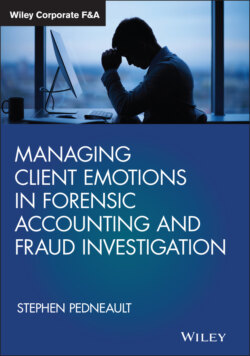Читать книгу Managing Client Emotions in Forensic Accounting and Fraud Investigation - Stephen Pedneault - Страница 13
ROLLERCOASTER
ОглавлениеDuring a fraud engagement, individuals may become frustrated, angry, or depressed. They may break down and start crying during parts of their story and then turn angry during others. It is prudent to prepare for mood changes and expect a rollercoaster ride of emotions. Throughout it all, actively listen to clients and allow them time to regain their composure as needed. The impact of being a victim of fraud, or being accused of fraud, is very personal and the individual will likely be under a significant amount of stress. Their emotional state may be very unstable, and they may feel violated, especially if trusted family members or friends are involved in the matter, which is often the case.
It is important to note that while I discuss the victim's perspective in this book, these points are equally valid when the fraud examiner meets with other individuals involved in the matter. Regardless of the individual's role in the matter, everyone is entitled to the same genuine, objective, nonjudgmental, and respectful approach, and they are entitled to tell their story. Remember, there are three versions of every story, and the fraud examiner's goal is to determine the most important one, the only version that matters: the truth.
The role of the fraud examiner is to determine what happened, to the extent possible, given the limitations that arise in every case. Limitations often include missing information, lost or deleted files, and lack of access to key individuals involved in the matter. It is not the role of the fraud examiner to determine guilt or innocence. That determination is the sole responsibility of the trier of fact – the judge or the jury. Thus, to the extent practical, even in the most difficult matters the fraud examiner needs to set aside casting judgment and instead focus on obtaining the facts, which at times is easier said than done.
However, in determining the facts, it is also important to recognize that fraud examiners are only human, and some matters involve very difficult details, especially when children and physical abuse are involved. I discuss strategies for the fraud examiner dealing with their own emotions later in the book.
Before we continue this journal of client emotions, I think a brief discussion regarding feelings versus emotions is warranted. Merriam‐Webster defines feelings as “one of the basic physical senses of which the skin contains the chief end organs and of which the sensations of touch and temperature are characteristic.”1 Included in the definition is “an emotional state or reaction.”2
Merriam‐Webster defines emotions as “a conscious mental reaction (such as anger or fear) subjectively experienced as strong feeling, usually directed toward a specific object and typically accompanied by physiological and behavioral changes in the body, a state of feeling.”3 While one definition appears to address to physical conditions while the other relates to nonphysical reactions, the terms have a relationship, as each word is used within the definition of the other. Throughout the rest of my book, I will refer to feelings and emotions simply as emotions.
In the next chapter, I advocate for an approach where the fraud examiner anticipates client emotions and chooses to address them rather than ignore them.
